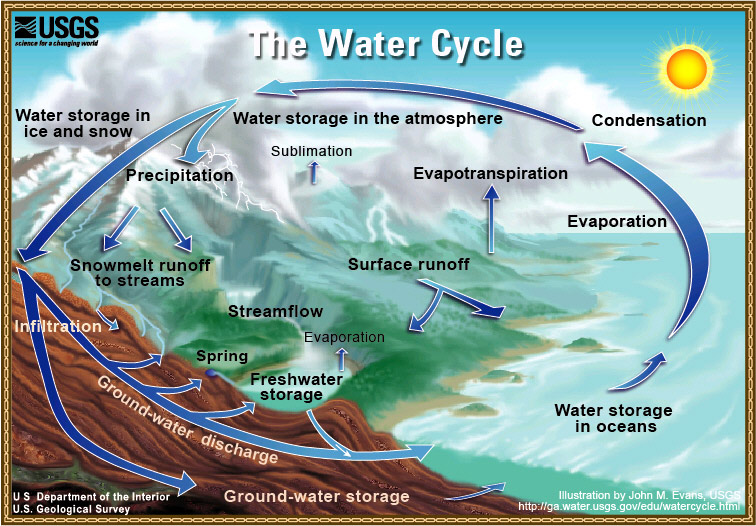We get a lot of questions on economic predictions around the predicted mega-droughts (what we are seeing now may be only the beginning of a very dry cycle for some), and it is interesting to look at this piece and understand the flow of water and you can imagine the changes in population, commerce, etc if that flow is a trickle.
Water is our most precious resource as we are about to find out.
The Western Water Cycle – From Snowpack to Stream
By Spencer Miller
 The water cycle is usually illustrated as a circular flow chart depicting water’s endless journey between ground and sky, rain and vapor. In Western states, where the majority of water falls as snow, the process works a bit differently.
The water cycle is usually illustrated as a circular flow chart depicting water’s endless journey between ground and sky, rain and vapor. In Western states, where the majority of water falls as snow, the process works a bit differently.Western mountains have snowpack, a reservoir of frozen water that melts and fills streams during dry spring and summer months. Too much snow or quickly-melting snow might mean flooding. A deficit could cause water shortage or drought.
Hydrologist Amy Burke from the USDA’s Natural Resources Conservation Service says snowpack accumulation usually occurs between October and April. April 1st is approximately the date the snowpack peaks. Normally, most snow melts between April and June.
Explaining the Western water cycle from the perspective of a single snowflake, Burke says, “A unique snowflake lands softly on top of a snowpack. Soon after, it’ll probably be crushed by the weight of more snow.” As the snowflake is assimilated into the snowpack, it loses its crystalline structure, morphing into a granular particle.
Throughout the season the snowpack becomes denser as increasing weight and freeze-thaw cycles compress the snow, says Burke. The next major event for the snowflake is ablation, which means the reduction of snowpack due to a combination of evaporation, sublimation and melt.
Sublimation is when water changes from solid to gas without becoming liquid. “That’s what’s happening in your freezer when an ice cube shrinks without melting,” says Burke. Sublimation occurs from snowpacks when the snow is very cold, the surrounding air is very dry, and the snow ablates without melting.
 The most likely method of snowpack ablation is melt. When our crushed, morphed snowflake melts into a drop of water, it either infiltrates into the soil or travels overland. “Think of the soil as a large sponge,” says Burke, “This spongy soil absorbs water until its pores are mostly full, then water flows over or through it.”
The most likely method of snowpack ablation is melt. When our crushed, morphed snowflake melts into a drop of water, it either infiltrates into the soil or travels overland. “Think of the soil as a large sponge,” says Burke, “This spongy soil absorbs water until its pores are mostly full, then water flows over or through it.”Snowmelt that infiltrates soil may be absorbed by plant roots (more on that later), evaporate out of the soil or reach a stream. Water flows naturally downstream until diverted by a canal or pipe, which transports it to a reservoir or agricultural field.
Reservoirs serve many purposes, including the storage of snowmelt. Eventually, snowmelt leaves the reservoir: it might evaporate; generate hydroelectric power as it continues downstream; or be used to irrigate a field.
When, at last, snowmelt reaches a field as irrigation water, it will either evaporate or be absorbed by plant roots. Water taken up by roots helps with plant hydration and cell construction. Eventually, the water evaporates or is transpired from the plant, a process known as evapotranspiration. Water vapor gathers in the atmosphere as clouds until it falls again, completing the water cycle.
Recognizing the influence of snowpack on Western water supply, NRCS snow surveyors regularly measure the water contained in Western snowpacks. Hydrologists and forecasters use these measurements to predict spring and summer streamflow in Western states. These forecasts serve as a vital planning tool for the region’s farmers, business owners and communities, especially in the wake of a prolonged drought still gripping much of the nation.

No comments:
Post a Comment